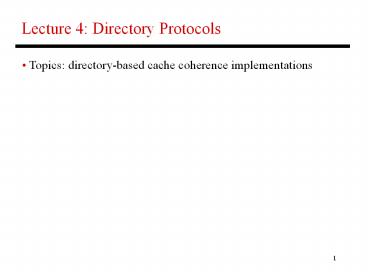Lecture 4: Directory Protocols - PowerPoint PPT Presentation
Title:
Lecture 4: Directory Protocols
Description:
Title: PowerPoint Presentation Author: Rajeev Balasubramonian Last modified by: Administator Created Date: 9/20/2002 6:19:18 PM Document presentation format – PowerPoint PPT presentation
Number of Views:44
Avg rating:3.0/5.0
Title: Lecture 4: Directory Protocols
1
Lecture 4 Directory Protocols
- Topics directory-based cache coherence
implementations
2
Split Transaction Bus
- What would it take to implement the protocol
correctly - while assuming a split transaction bus?
- Split transaction bus a cache puts out a
request, releases - the bus (so others can use the bus), receives
its response - much later
- Assumptions
- only one request per block can be outstanding
- separate lines for addr (request) and data
(response)
3
Split Transaction Bus
Proc 1
Proc 2
Proc 3
Cache
Cache
Cache
Request lines
Response lines
4
Design Issues
- When does the snoop complete? What if the snoop
takes - a long time?
- What if the buffer in a processor/memory is
full? When - does the buffer release an entry? Are the
buffers identical? - How does each processor ensure that a block does
not - have multiple outstanding requests?
- What determines the write order requests or
responses?
5
Design Issues II
- What happens if a processor is arbitrating for
the bus and - witnesses another bus transaction for the same
address? - If the processor issues a read miss and there is
already a - matching read in the request table, can we
reduce bus - traffic?
6
Scalable Multiprocessors
P1
P2
Pn
C1
C2
Cn
Mem 1
CA1
Mem 2
CA2
Mem n
CAn
Scalable interconnection network
CC NUMA Cache coherent non-uniform memory access
7
Directory-Based Protocol
- For each block, there is a centralized
directory that - maintains the state of the block in different
caches - The directory is co-located with the
corresponding memory - Requests and replies on the interconnect are no
longer - seen by everyone the directory serializes
writes
P
P
C
C
Mem
CA
Dir
Mem
CA
Dir
8
Definitions
- Home node the node that stores memory and
directory - state for the cache block in question
- Dirty node the node that has a cache copy in
modified state - Owner node the node responsible for supplying
data - (usually either the home or dirty node)
- Also, exclusive node, local node, requesting
node, etc.
P
P
C
C
Mem
CA
Dir
Mem
CA
Dir
9
Protocol Steps
P1
P2
Pn
C1
C2
Cn
Mem 1
CA1
Mem 2
CA2
Mem n
CAn
Dir
Dir
Dir
Scalable interconnection network
- What happens on a read miss and a write miss?
- How is information stored in a directory?
10
Directory Organizations
- Centralized Directory one fixed location
bottleneck! - Flat Directories directory info is in a fixed
place, - determined by examining the address can be
further - categorized as memory-based or cache-based
- Hierarchical Directories the processors are
organized as a - logical tree structure and each parent keeps
track of which - of its immediate children has a copy of the
block less - storage (?), more searching, can exploit
locality
11
Flat Memory-Based Directories
- Directory is associated with memory and stores
info - for all cache copies
- A presence vector stores a bit for every
processor, for - every memory block the overhead is a function
of - memory/block size and processors
- Reducing directory overhead
12
Flat Memory-Based Directories
- Directory is associated with memory and stores
info - for all cache copies
- A presence vector stores a bit for every
processor, for - every memory block the overhead is a function
of - memory/block size and processors
- Reducing directory overhead
- Width pointers (keep track of processor ids of
sharers) - (need overflow strategy), 2-level protocol to
combine - info for multiple processors
- Height increase block size, track info only for
blocks - that are cached (note cache size ltlt memory
size)
13
Flat Cache-Based Directories
- The directory at the memory home node only
stores a - pointer to the first cached copy the caches
store - pointers to the next and previous sharers (a
doubly linked - list)
Main memory
Cache 7
Cache 3
Cache 26
14
Flat Cache-Based Directories
- The directory at the memory home node only
stores a - pointer to the first cached copy the caches
store - pointers to the next and previous sharers (a
doubly linked - list)
- Potentially lower storage, no bottleneck for
network traffic, - Invalidates are now serialized (takes longer to
acquire - exclusive access), replacements must update
linked list, - must handle race conditions while updating list
15
Data Sharing Patterns
- Two important metrics that guide our design
choices - invalidation frequency and invalidation size
turns out - that invalidation size is rarely greater than
four - Read-only data constantly read, never updated
(raytrace) - Producer-consumer flag-based synchronization,
updates - from neighbors (Ocean)
- Migratory reads and writes from a single
processor for a - period of time (global sum)
- Irregular unpredictable accesses (distributed
task queue)
16
Protocol Optimizations
3
C1
C2
C1 attempts to read a block that is in Modified
state in C2
4
2
1
5
Mem
Request Response
3
C1
C2
C1
C2
2
2
3
4
4
1
1
Mem
Mem
Intervention Forwarding
Reply Forwarding
17
Serializing Writes for Coherence
- Potential problems updates may be re-ordered by
the - network General solution do not start the
next write until - the previous one has completed
- Strategies for buffering writes
- buffer at home requires more storage at home
node - buffer at requestors the request is forwarded
to the - previous requestor and a linked list is
formed - NACK and retry the home node nacks all requests
- until the outstanding request has completed
18
Title
- Bullet































